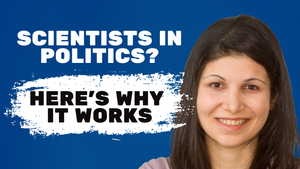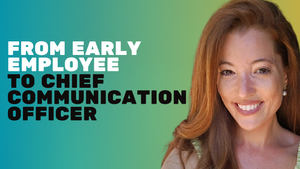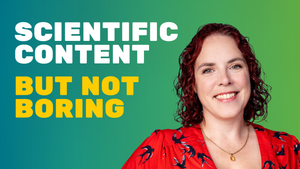🎧 Listen to this episode:
🔔 Subscribe to the podcast
🎥 Watch it on YouTube
📖 Or read the summary of the interview:
Science doesn’t exist in a vacuum. It shapes our world, but it is also shaped by public opinion, funding decisions, and political battles. Yet most scientists—and many science marketers—are reluctant to step into political spaces, often dismissing them as too messy or partisan.
Sheeva Azma sees things differently. As CEO of Fancy Comma and author of Science x Marketing, her career spans neuroscience research, political campaigning, and science communication. In a recent episode of The Science Marketer Podcast, I had the chance to speak with her about how political experience has informed her approach to marketing and communication.
Her insights point to a surprising conclusion: if science is to thrive, its communicators need to think more like campaign strategists.
This article highlights five key takeaways from the conversation that every science marketer and communicator can use.
Let's dive in!
1. Science needs politics, and politics needs science
Science and politics are deeply intertwined, whether scientists like it or not. Research funding, regulatory frameworks, and even the public’s trust in science are shaped by political decisions.
Sheeva has lived this reality firsthand. She worked on political campaigns, co-founded Scientists for Harris during Kamala Harris’s presidential bid, and later organized a Stand Up for Science rally in Oklahoma City. That rally brought 100 researchers out of their labs and onto the steps of the Capitol to protest cuts to NIH and NSF funding.
“I don’t think that a non-scientist would have been able to get so many scientists to come to this rally,” she reflected.
The rally succeeded not just because of passion but because Sheeva applied political communication tactics: designing compelling flyers, calling lawmakers directly, and framing the event for positive media coverage.
For communicators, the lesson is clear. Science cannot afford to ignore politics. Engaging with policymakers, advocacy groups, and even grassroots movements ensures that scientific perspectives shape decisions that affect everything from climate policy to drug approvals.
2. Optics matter, even for scientists
In academia, accuracy is the highest value. But in politics, perception often matters just as much as facts. Sheeva discovered this during her time volunteering for astronaut Mark Kelly’s Senate campaign.
“The way you present yourself matters in Congress… That’s something really valuable in science communication, because we never think of how other people see us as scientists”.
Kelly’s campaign made constant use of his astronaut background, framing him as a leader who knew how to solve problems and dream big. This wasn’t about data points or journal citations, but about image and narrative.
Scientists often resist this focus on optics, assuming their work should speak for itself. But as Sheeva points out, politicians control science funding in the U.S., and their decisions are influenced by image as much as substance.
For science marketers, the takeaway is that presentation amplifies credibility. The way you frame your research, your product, or your company can determine whether people trust you or tune you out. Accuracy is non-negotiable, but without clarity and polish, accuracy alone isn’t enough.
3. Borrow campaign strategies for life sciences marketing
Political campaigns are laboratories of communication. Every message is tested, every slogan polled, every strategy scrutinized for resonance. Sheeva argues that life sciences companies could adopt similar approaches, particularly when communicating complex or controversial issues.
During the COVID-19 pandemic, she worked with numerous biotech companies. What set her apart was her hybrid skill set: scientific training combined with PR and marketing expertise. That unique mix made her especially valuable in shaping messages that were both credible and accessible.
“You have to say something that’s really clear, you have to say it in a way that other people will get the message… and it also fits the brand, but it’s also scientific”.
Sheeva believes pharma companies missed an opportunity during the vaccine rollout. Instead of relying solely on legally approved press releases, they could have adopted campaign-style tactics, using polling to understand public concerns and then tailoring their messaging accordingly.
“It would have been nice if someone had hired a politics consulting firm to ask people: what are their thoughts on vaccines? What are their thoughts on these therapeutics? And then develop a message informed by polling, kind of like politicians do with their messages”.
For marketers, the lesson is to think like a political campaign manager. Test your messages. Anticipate skepticism. Shape narratives that resonate emotionally, not just intellectually.
4. Step out of the lab and into the community
Scientists often remain siloed, speaking mostly to colleagues and specialists. Politics forces you out of that comfort zone, knocking on doors, talking to strangers, and listening to people with no scientific background.
Sheeva argues that this is invaluable training for communication.
“You gain really important one-on-one relational experience talking to people… and you can use that experience in your marketing”.
She encourages scientists to volunteer on campaigns or simply engage more with their communities. These experiences help communicators understand how non-experts perceive science and how to bridge the gap.
For marketers, the implication is simple: build messages for real people, not just peers. Avoid jargon. Listen actively. Recognize that curiosity, skepticism, and even resistance are part of how the public processes scientific information.
Stepping into community conversations also helps communicators craft more relatable content. Whether you’re marketing a new therapy, a diagnostic tool, or a biotech brand, the people you’re trying to reach are rarely scientists themselves. Campaigning is a crash course in meeting them where they are.
5. Elect more scientists
Sheeva doesn’t mince words when it comes to the ultimate solution for science’s political challenges: “I think the only solution is to elect more scientists to office”.
Why? Because political decisions are increasingly made without input from scientific experts. She points to the recent appointment of Robert F. Kennedy Jr., a prominent vaccine skeptic, to a top U.S. health role. Despite assurances that vaccine policy would remain untouched, one of his first moves was to change vaccine recommendations.
This underscores the risks of leaving science outside the political process. Without scientists at the table, misinformation and ideology can override evidence.
Even in smaller ways, Sheeva notes, the absence of scientific advisors shows up in lawmakers’ communications. “I’ve definitely seen minor science errors in the tweets and posts from our lawmakers… I just wish the conversation was a bit more precise”.
For science communicators, the takeaway is both a warning and an opportunity. By supporting scientists who run for office—or even by encouraging more engagement in advisory roles—we can help ensure that policymaking reflects reality rather than rhetoric.
Why politics is a masterclass in communication
At its core, politics is about persuasion. Campaigns are designed to connect with people, earn their trust, and mobilize them to act. For Sheeva, this makes politics a masterclass in communication strategy, one that scientists and marketers alike can learn from.
“You kind of develop this strategic mind from politics that you really don’t get in science in the same way”.
This doesn’t mean abandoning rigor or compromising integrity. It means recognizing that evidence alone rarely wins hearts and minds. Strategy, storytelling, and empathy are equally essential.





